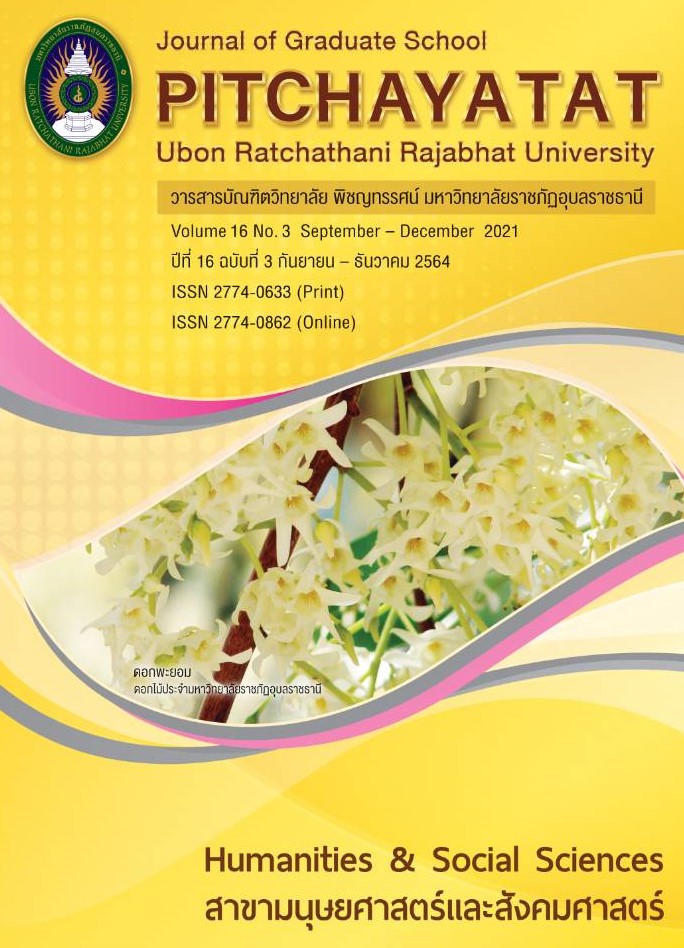การพัฒนารูปแบบการจัดกิจกรรมหน้าเสาธงและการแต่งเครื่องแบบนักเรียนสำหรับโรงเรียนสาธิตมหาวิทยาลัยมหาสารคาม (ฝ่ายมัธยม)
คำสำคัญ:
รูปแบบการจัดกิจกรรมหน้าเสาธง การแต่งเครื่องแบบนักเรียนบทคัดย่อ
การวิจัยในครั้งนี้มีความมุ่งหมาย 1) เพื่อศึกษาความต้องการรูปแบบการจัดกิจกรรมหน้าเสาธงและการแต่งเครื่องแบบนักเรียนของโรงเรียนสาธิตมหาวิทยาลัยมหาสารคาม (ฝ่ายมัธยม) 2) เพื่อพัฒนารูปแบบการจัดกิจกรรมหน้าเสาธงและการแต่งเครื่องแบบนักเรียนของโรงเรียนสาธิตมหาวิทยาลัยมหาสารคาม (ฝ่ายมัธยม) แบ่งเป็น 3 ระยะ ได้แก่ ระยะที่ 1 ศึกษาความต้องการรูปแบบการเข้าแถวหน้าเสาธงและการแต่งกายที่เหมาะสมโดยการศึกษาเชิงสำรวจ (Survey study) เครื่องมือที่ใช้ ได้แก่ แบบสอบถามแบบออนไลน์ ซึ่งมีผู้ตอบแบบสอบถามผ่าน Google Form จำนวน 885 คน ระยะที่ 2 พัฒนารูปแบบการเข้าแถวหน้าเสาธงและการแต่งกาย โดยใช้การประชุมคณะกรรมการบริหารโรงเรียนเพื่อหาข้อสรุป ระยะที่ 3 นำรูปแบบที่ได้จากข้อสรุปของคณะกรรมการบริหารโรงเรียนไปทดลองใช้ 1 เดือนแล้วสำรวจความคิดเห็นจากผู้ตอบแบบสอบถามออนไลน์ผ่าน Google Form จำนวน 552 คน การวิเคราะห์ข้อมูลใช้ค่าเฉลี่ย ส่วนเบี่ยงเบนมาตรฐาน และร้อยละ
สรุปผลได้ดังนี้
- ผู้ตอบแบบสอบถามเห็นด้วยมากที่สุดที่โรงเรียนควรจัดให้มีกิจกรรมเข้าแถวหน้าเสาธง 3 วัน/สัปดาห์ เวลาเริ่มทำกิจกรรมหน้าเสาธงที่เหมาะสมคือ 8.00 น. และเริ่มเรียนในชั่วโมงแรกของวันเวลา 8.30 น. เห็นด้วยมากที่สุดที่ให้นักเรียนแต่งเครื่องแบบนักเรียน 3 วัน อีก 2 วันเป็นชุดสุภาพกางเกงขายาว รองเท้าหุ้มส้น
2. ข้อสรุปจากคณะกรรมการบริหารโรงเรียนเห็นด้วยให้ปรับเวลาเข้าแถวหน้าเสาธง จาก 07.45 น. เป็น 07.55 น. และลดกิจกรรมหน้าเสาธงลงเพื่อให้นักเรียนได้พบอาจารย์ที่ปรึกษาในช่วงเช้าเป็นลักษณะกลุ่มย่อย และเห็นด้วยให้นักเรียนสามารถแต่งชุดสุภาพมาโรงเรียนได้สัปดาห์ละ 1 วัน และหลังจากทดลองใช้รูปแบบการเข้าแถวและการแต่งชุดสุภาพมาโรงเรียนเป็นระยะเวลา 1 เดือน ผู้วิจัยได้สำรวจความคิดเห็นจากผู้ตอบแบบสอบถาม พบว่า ผู้ตอบแบบสอบถามเห็นด้วยมากที่บอกว่าการแต่งชุดสุภาพมาโรงเรียนได้ สามารถสร้างแรงจูงใจในการมาโรงเรียนของนักเรียนได้ และเป็นการเพิ่มความคิดสร้างสรรค์ของนักเรียน และไม่เห็นด้วยที่มองว่ามีผลเสียมากกว่าผลดี ทำให้ผู้ปกครองต้องเพิ่มรายจ่ายมากขึ้น และทำให้เกิดการแบ่งแยกชนชั้นระหว่างคนรวยกับคนจน และเห็นด้วยน้อยมากที่บอกว่าการแต่งชุดสุภาพมาโรงเรียน ทำให้วินัยนักเรียนแย่ลง
เอกสารอ้างอิง
กุลยา ตันติผลาชีวะ. “การฝึกวินัยเด็ก,” การศึกษาปฐมวัย, 3, 2 (2542)
คณะกรรมการวัฒนธรรมแห่งชาติ, สำนักงาน. การสร้างเสริมวินัย คู่มือแนะแนวทางปฏิบัติ. กรุงเทพฯ: โรงพิมพ์คุรุสภาลาดพร้าว, 2537.
ฆนัท ธาตุทอง. สอนคิด : การจัดการเรียนรู้เพื่อพัฒนาการคิด. นครปฐม: เพชรเกษมการพิมพ์, 2554.
ชวนพิศ ชุ่มวัฒนะ และกิตติมา โมะเมน. เทคนิคการจัดกิจกรรมเพื่อสอนทักษะชีวิตสำหรับเยาวชน. กรุงเทพฯ: สำนักงาน ป.ป.ส. กระทรวงยุติธรรม, 2549.
ทิศนา แขมมณี. ศาสตร์การสอน องค์ความรู้เพื่อการจัดกระบวนการเรียนรู้ที่มีประสิทธิภาพ. พิมพ์ครั้งที่ 9. กรุงเทพฯ: สำนักพิมพ์แห่งจุฬาลงกรณ์มหาวิทยาลัย, 2552.
นิราศ จันทรจิตร. การจัดการเรียนรู้ที่มีประสิทธิภาพ. มหาสารคาม: ตักสิลาการพิมพ์, 2558.
บุญชม ศรีสะอาด. การวิจัยเบื้องต้น. พิมพ์ครั้งที่ 8. กรุงเทพฯ: สุวีริยาสาส์น, 2553.
ศึกษาธิการ, กระทรวง. พระราชบัญญัติการศึกษาแห่งชาติ พ.ศ. 2542 และที่แก้ไขเพิ่มเติม (ฉบับที่ 2) ปี พ.ศ. 2545. กรุงเทพฯ: องค์การรับส่งสินค้าและพัสดุภัณฑ์, 2546.
สายชล สินสมบูรณ์ทอง. สถิติเบื้องต้น. พิมพ์ครั้งที่ 11. กรุงเทพฯ: สำนักพิมพ์จุฬาลงกรณ์, 2560.
Afari, E., G. Ward and M. Khine. “Global Self-esteem and Self-efficacy Correlates: Relation of Academic Achievement and Self-esteem among Emirati Students,” International Education Studies. 5, 2 (April 2012): 49-57.
Aydin, B. “Teacher Concepts on Students’ Obtaining Self-control,” Procedia Social and Behavioral Sciences. 1 (January 2009): 1244-1248.
Bergin, C. and D.A. Bergin. “Classroom Discipline that Promotes Self-control,” Journal of Applied Developmental Psychology. 20, 2 (June 1999): 189-206.
Kepalaitè, A. “Changes in the Self-esteem and Anxiety of Older Adolescents Resulting from the Application of Psychological Intervention,” Specialusis Ugdymas. 2, 25 (2011): 16-24.
ดาวน์โหลด
เผยแพร่แล้ว
รูปแบบการอ้างอิง
ฉบับ
ประเภทบทความ
สัญญาอนุญาต
ลิขสิทธิ์ (c) 2021 วารสารบัณฑิตวิทยาลัย พิชญทรรศน์ มหาวิทยาลัยราชภัฏอุบลราชธานี

อนุญาตภายใต้เงื่อนไข Creative Commons Attribution-NonCommercial-NoDerivatives 4.0 International License.
บทความทุกเรื่องได้รับการตรวจความถูกต้องทางวิชาการโดยผู้ทรงคุณวุฒิภายนอกอย่างน้อย 2 คน ความคิดเห็นในวารสารบัณฑิตวิทยาลัย พิชญทรรศน์ มหาวิทยาลัยราชภัฏอุบลราชธานี เป็นความคิดเห็นของผู้เขียนมิใช่ความคิดเห็นของผู้จัดทำ จึงมิใช่ ความรับผิดชอบของบัณฑิตวิทยาลัย มหาวิทยาลัยราชภัฏอุบลราชธานี และบทความในวารสารบัณฑิตวิทยาลัย พิชญทรรศน์ มหาวิทยาลัยราชภัฏอุบลราชธานี สงวนสิทธิ์ตามกฎหมายไทย การจะนำไปเผยแพร่ต้องได้รับอนุญาตเป็นลายลักษณ์อักษรจากกองบรรณาธิการ






